|
The Battle of the Atlantic, Convoys in WW-II
 Keeping a constant flow of food, row materials and military supply to Britain and later on during the war to Russia, opening a second/eastern front against Germany, was a vital role played by merchant shipping. Keeping a constant flow of food, row materials and military supply to Britain and later on during the war to Russia, opening a second/eastern front against Germany, was a vital role played by merchant shipping.
Whereas in World War I the presence of `escort` had been sufficient to ensure convoy safety, the increasingly aggressive `Wolf Packs` tactics of World War II brought unsatisfactory results for the Allies, and that is to say the leas.
In September 1941, in one running battle along the coast of Greenland, 16 ships, 24% of the total in a convoy, were sunk. Another convoy in the same month lost 7 of the 12 escorted merchantmen.
By July 1942, `Wolf Packs` could be directed to follow and attack any westbound convoy, refuel, then pick on an eastbound convoy. Thus began the true Battle of the Atlantic. It was to continue for 11 months and score some 712 merchant victims. Total allied losses for the war to that point, 14,000,000 tons, the replacement less then half. New U-boats were joining the fleet at a rate of almost one a day.
It looked as if Donitz had won the war.
But the tide was soon turning.
The Germen navy counted upon and needed its radio communications in order to gather the `Wolf Packs` and direct them to the convoys. The allies improved their HF/DF ability to track and intercept those communications. Further more the Ultra, the British code breaking project to crack the German Enigma, proved to be fruitful and was gaining momentum. Up until the end of war the German navy did not know or wasn`t positively sure that the British had managed to decipher its transmissions and there for keep track of all submarine moves, it was accepted by all in German Rich that the Enigma is unbreakable.
 To that it is needed to add the improvement made to radar and sonar detection effectiveness, to ASW, Anti Submarine Warfare, measures such as torpedo, depth charges and by introducing of the Hedgehog-a multiple mortar launcher, mounted forward of the bridge of an escort ship, carrying 24 sixty-five pound projectiles arranged to cover a hundred-foot circle 230 yards in front of the launcher To that it is needed to add the improvement made to radar and sonar detection effectiveness, to ASW, Anti Submarine Warfare, measures such as torpedo, depth charges and by introducing of the Hedgehog-a multiple mortar launcher, mounted forward of the bridge of an escort ship, carrying 24 sixty-five pound projectiles arranged to cover a hundred-foot circle 230 yards in front of the launcher
The ever increasing use of airplanes for sea surveillance, air coverage for convoys, detecting and attacking submarines, made the difference.
In May 1942 the German navy calculated that the Tonnage War would be won with a monthly target of 700,000 tons. By July 1943 all new tonnage produced by US shipyards was to pass all wartime losses. A massive production of Liberty ships, design to replace the Tonnage War losses, acceded all German`s calculation by a factor of two.
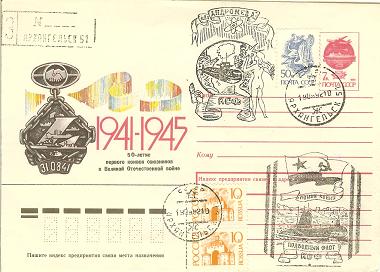 |
USSR - Soviet Union |
|
50th anni' WW-II allied convoys, SSBN Andromeda (K-420 Yankee class- Project 667M), Remember the war- Submarine fleet (Foxtrot class), 24 Jan' 1991 |
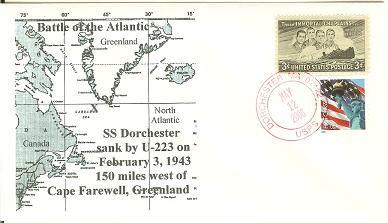 |
United States |
|
The four Immortal Chaplains- Battle ot the Atlantic, SS Dorchester sank by U-223 on Feb' 3, 1943, Dorchester MA, 12 May, 2006 |
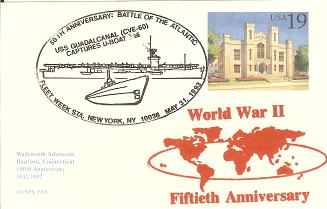 |
United States |
|
50th Anniversary:Battle of the Atlantic, USS Guadalcanal (CVE-60) captures U-Boat U-505, New York NY, 31 May, 1993 |
 |
Poland |
1943 |
Convoy under airplane attack |
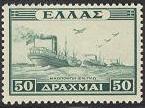 |
Greece |
1947 |
Ships in a convoy |
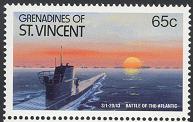 |
Saint Vincent & Grenadines |
1990 |
1-20 March 1943 battal of the Atlantic. German U-Boat pursuing a convoy |
 |
Canada |
1992 |
1942 U-Boat offshore. Attacking merchant ship convoy |
 |
Canada |
1993 |
1943 Battle of the Atlantic. Escorts attacking U-Boat |
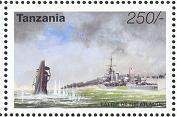 |
Tanzania |
1995 |
Battle of the Atlantic.Sinking a U-Boat |
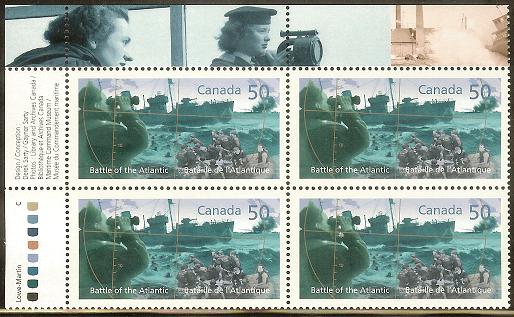 |
Canada |
2005 |
60th anni' Battle of the Atlantic. Attack on a convoy through a periscope (single stamp) |
|